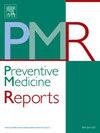健康素养与癌症筛查参与度之间的关系:对丹麦三个有组织筛查计划的横断面研究
IF 2.4
3区 医学
Q2 PUBLIC, ENVIRONMENTAL & OCCUPATIONAL HEALTH
引用次数: 0
摘要
目的健康素养可能与不参与癌症筛查有关,但对其与参与所有癌症筛查计划之间的关系了解有限。本研究旨在探讨健康素养与促进参与癌症筛查计划之间的关系。方法:我们于2018年3月31日对居住在丹麦的53-65岁女性进行了一项横断面研究。使用的数据来自2017年秋季收集的人口登记和自我报告的健康素养(HLS-EU-Q16)。采用单变量和多变量有序逻辑回归模型来评估健康素养水平与癌症筛查项目出勤率增加的可能性之间的关系。结果以95%置信区间(ci)的优势比(ORs)表示。结果有2668名妇女(69.8%)回答了健康素养问卷。在这些人中,53.3%表现出足够的健康素养,34.4%表现出问题,12.3%表现出不足。总的来说,71.2%参加了三次筛查计划,20.1%参加了两次,6.2%参加了一次,2.5%没有参加。当比较有问题(OR = 1.18, 95% CI: 0.97-1.42)或不充分(OR = 0.96, 95% CI: 0.74-1.26)健康素养水平与适当水平时,提前筛查出勤率的OR值没有差异。结论我们的研究表明,健康素养对丹麦研究人群的癌症筛查参与没有显著影响。因此,旨在增加这一群体的筛查参与的干预措施不仅应以健康素养为目标,还应关注不参与的其他方面。本文章由计算机程序翻译,如有差异,请以英文原文为准。
The association between health literacy and cancer screening participation: A cross-sectional study across three organised screening programmes in Denmark
Objective
Health literacy may be related to non-participation in cancer screening, but there is limited understanding of its association with participation across all cancer screening programmes. This study aims to explore the associations between health literacy and advancing in participation in cancer screening programmes.
Methods
We conducted a cross-sectional study involving women aged 53–65 years residing in Denmark on 31 March 2018. Data utilised was from population registries and self-reported health literacy (HLS-EU-Q16) collected autumn 2017. Uni- and multivariate ordinal logistic regression models were employed to assess associations between health literacy levels and the likelihood of increased attendance in cancer screening programmes. Results were presented as odds ratios (ORs) with 95 % confidence intervals (CIs).
Results
Of the women included, 2668 (69.8 %) responded to the health literacy questionnaire. Among these, 53.3 % demonstrated adequate health literacy, 34.4 % had problematic, and 12.3 % inadequate. In total, 71.2 % attended three screening programmes, 20.1 % attended two, 6.2 % attended one, and 2.5 % attended none.
There were no differences in the ORs for advancing in screening attendance when comparing problematic (OR = 1.18, 95 % CI: 0.97–1.42) or inadequate (OR = 0.96, 95 % CI: 0.74–1.26) health literacy levels with an adequate level.
Conclusions
Our study suggests that health literacy does not significantly influence cancer screening participation among the studied population in Denmark. Therefore, interventions aimed at increasing screening participation in this group should not only target health literacy but also focus on other aspects of non-participation.
求助全文
通过发布文献求助,成功后即可免费获取论文全文。
去求助
来源期刊

Preventive Medicine Reports
Medicine-Public Health, Environmental and Occupational Health
CiteScore
3.90
自引率
0.00%
发文量
353
 求助内容:
求助内容: 应助结果提醒方式:
应助结果提醒方式:


